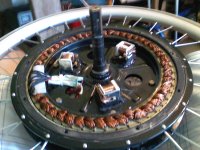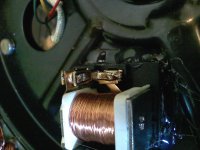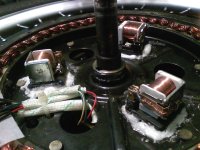tostino
10 kW
Well I completed building the 3rd revision of my bike a couple weeks ago, and i've just been tweaking it since.
The bike is a Sun EZ-1 Super Cruzer that I got for $150. It needed new tires, but that was all that was wrong with it. No rust or anything.
I got a 9c motor from Ebike-Kit laced into a 20" wheel. I had to dish it a little, and also bend my dropouts, and make a spacer that goes under the sprocket and contacts the frame.
After I got the motor fitted to the bike, and took it for a few test rides, it was time to rip the motor off the bike, and tear into it. It was time to mod it for delta/wye.
After opening the motor up, I noticed there was enough room inside to mount the relays, rather than bringing out 6 phase wires from that little shaft.

I modded the relays with solder wick to be able to handle more current without heating up.

View attachment 2
Detached the phase wire terminations.

I then got down to hooking it all together.

In the last photo, look closely at the hall ground wire, I cut it, and am using it as the ground for my relays. It then goes through a 200ohm resistor, and the three relays. On my handle bars, I have a switch that will energize my frame, and this engages the relays to switch to delta. With relays off the motor is in wye.
The bike is a Sun EZ-1 Super Cruzer that I got for $150. It needed new tires, but that was all that was wrong with it. No rust or anything.
I got a 9c motor from Ebike-Kit laced into a 20" wheel. I had to dish it a little, and also bend my dropouts, and make a spacer that goes under the sprocket and contacts the frame.
After I got the motor fitted to the bike, and took it for a few test rides, it was time to rip the motor off the bike, and tear into it. It was time to mod it for delta/wye.
After opening the motor up, I noticed there was enough room inside to mount the relays, rather than bringing out 6 phase wires from that little shaft.

I modded the relays with solder wick to be able to handle more current without heating up.

View attachment 2
Detached the phase wire terminations.

I then got down to hooking it all together.

In the last photo, look closely at the hall ground wire, I cut it, and am using it as the ground for my relays. It then goes through a 200ohm resistor, and the three relays. On my handle bars, I have a switch that will energize my frame, and this engages the relays to switch to delta. With relays off the motor is in wye.









